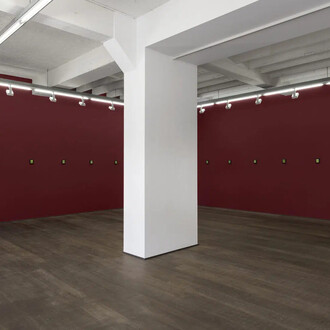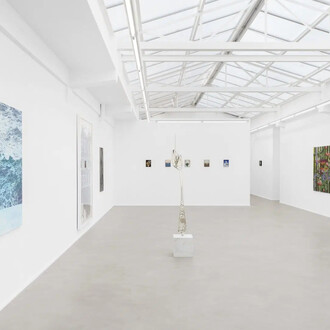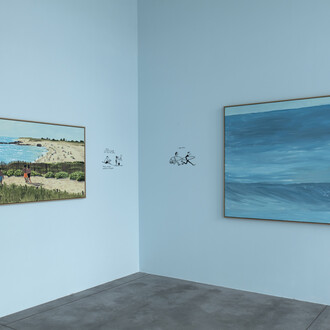Xavier Hufkens is delighted to present American artist Lynda Benglis’ (b. 1941) first solo presentation with the gallery. For over six decades, Benglis has consistently challenged artistic conventions to produce an oeuvre that is unrivalled in its formal range and material richness. Latex, polyurethane, beeswax, glass, ceramics, paper, bronze, aluminium and lead, as well as film, video and photography, are all mediums to which she frequently returns. She gained recognition through her poured latex sculptures in the late 1960s/ early 1970s and for subverting the gender stereotypes of the era, most notably through the groundbreaking advertisement she took out in the November 1974 issue of Artforum.
In this presentation, a series of recent wall-mounted ‘sparkle paper’ sculptures are shown in conjunction with a group of ceramics. Although seemingly incongruous in terms of scale and technique, the works on view share interesting similarities of approach and are consummate examples of the artist’s radical take on materials and processes.
The glitter-saturated sculptures exemplify Benglis’ instinctual approach to form and colour. To create these works, she moulds sheets of wet, glitter-soaked paper around a metal armature made from chicken wire. Once dry, the works are sometimes augmented with expressive gestures in black tempera made with coal dust. Wire, glitter and paper are not new materials to Benglis, who first started experimenting with such media in the early 1970s. The columnar form is also a recurring motif. Tactile, refractive and alive with movement, the surfaces of the works express the principal leitmotiv in Benglis’ oeuvre, namely the visual representation of material in action, or what is often termed ‘the frozen gesture’. Benglis smooths the sensual and malleable paper – as fragile as human tissue – around the armatures like a skin; a process that she likens to “fleshing the form out.” The duality of the works is even reflected in the creative process, which involves brute physical force (two people to manipulate the wire) and manual dexterity (shaping the paper).
Benglis uses a similar combination of techniques to create her ceramics, which are partially made using an industrial extruder (which produces uniform circular or squared tubes of clay) but also by hand, with the artist shaping, bending, tangling and collapsing the forms before painting and glazing them in a rich palette of evocative and painterly hues. As with the paper sculptures, physical contact with the object is paramount. Benglis says: “With ceramics, I feel a need to kind of wrestle with the material and be integrated with the form and the surface.” In these free-standing works – which can simultaneously be read as sculptures, ceramics and paintings – Benglis demolishes the traditional divisions between artistic disciplines, as well as that between ‘art’ and ‘craft’, to create what art historian Bibiana Obler calls ‘antivessels’. As Benglis herself explains: “My work is an expression of space. What is the experience of moving? Is it pictorial? Is it an object? Is it a feeling? It all comes from my body. I am the clay; I have been extruded, in a sense. How to tie it together? … I am the form… They are pictorial. This is as near to painting as I’ve been.”
Lynda Benglis (b. 1941, Lake Charles, LA, USA) lives and works between New York, Santa Fe and Greece. Recent solo exhibitions include: Lynda Benglis: In the Realm of the Senses, Museum of Cycladic Art, Athens, Greece (2019); Lynda Benglis, Locks Gallery, Philadelphia, PA, USA (2019); Lynda Benglis: Secrets, Bergen Assembly, KODE Art Museums of Bergen, Norway (2016); Cuerpos, Materia y Alma: Las Esculturas de Lynda Benglis [Bodies, Matter and Soul: The Sculptures of Lynda Benglis], Museo International del Barroco, Puebla, Mexico (2016); Lynda Benglis, Hepworth Wakefield, Wakefield, West Yorkshire, UK (2015); Lynda Benglis: Water Sources, Storm King Art Center, New Windsor, NY, USA (2015). Her work is represented in museum collections around the world including MOMA, Tate Modern, Whitney Museum of American Art, Los Angeles County Museum of Art and the Guggenheim.
















